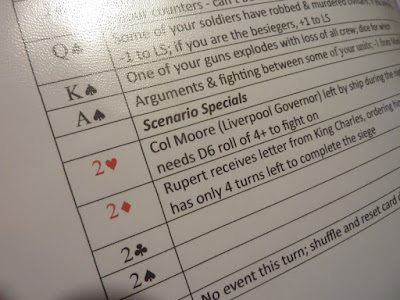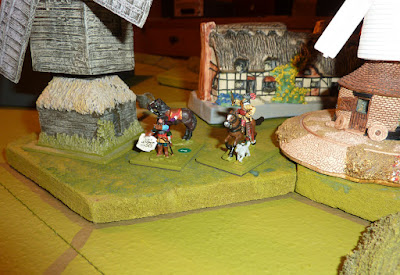Last night I hosted the actual game, having talked about it for long enough. The draft rules worked pretty well - a few things need fixing, but we worked around most of the issues we came across.
Once again, my sincere thanks to the Jolly Broom Man for joining me on Zoom to play through another piece of historical tragedy. A very rewarding evening.
Royalist field artillery in action on the high ground near Everton
The build up to this siege has been sketched out in a previous post, so last night was all about getting on with it. Some sort of narrative should emerge from the photos; I'll briefly discuss rules matters later.
Things are very peaceful, before Prince Rupert's army arrives on the field. The end of the field nearest the camera is marshy - a no-go area
Two teams of sappers, relaxing in the grounds of the Castle before All Hell arrives
Rupert's besieging force arrives in the "safe area" outside the lines; he also had more troops available to assist in the event of a storm, but initially they were busy making gabions and cutting down trees. As you do... The giant dice is to ensure that everyone can see the day's "digging number", which later had quite an impact when it became so high that the Royalist troops were struggling to complete building parts of the 2nd Parallel before the sun came up!
Sappers at work, zig-zagging their way towards the fortress - the brown felt strips work well, but don't look like hard cover, which is what they count as. The little stand of gabions is to remind us that they are not sitting ducks (and it is night time, after all)
An early trench raid - two companies of Meldrum's garrison troops, under cover of darkness, attack sappers on the job, and have brought some sappers of their own, to collapse the sap if the Royalist sappers are driven out. As I recall, this particular raid failed
We were using an Event Card system. To keep the number of events down to sensible levels, the active player had to roll a 5 or 6 on a D6 to draw a card. Sod's Law came into play very early; I had worked two historical events in as "Scenario Specials", and after only a few turns one came up...
... yes, it was a long shot, but Colonel Moore abandoned his fortress, leaving by boat during the night, which is exactly what he did back in 1644. The garrison suffered a loss of morale points, but passed the D6 roll required to continue fighting without him
At this stage, the garrison's field guns were taking something of a hammering from the heavier Royalist pieces, and one of Martindale's first actions after taking over as Governor was to abandon the hornwork outside the North end of the town
Here Rupert gets his boys busy with the construction of a 2nd Parallel
The Royalists are digging forward from the East and the North
No immediate panic, but the garrison are beginning to run out of guns; since the port is still open to the river, there is no shortage of powder or ammunition, but guns are becoming a problem
Here is Rupert, accompanied by his famous magnetic dog, which for extra security is stuck on with BluTak for the day. Shortly after this photo, the Event Cards struck again, and announced that one of the Royalist senior officers had been killed - dice to identify which one. It was Rupert. I don't know what happened to the dog. Lord John Byron succeeded to the command, but it took a little while, during which the Royalists were unable to rally any of their damaged units
Mechanisms; markers; this shows that the Local Support rating for the townspeople (which can range from +3 to -3) is currently higher than you might expect, given the circumstances
Another trench raid; despite plentiful infantry support, the sappers were driven back on this occasion, and the garrison had cause to regret that they had not attached sappers of their own to the raid, who could have destroyed the forward sap. Oh well...
The sappers were soon back on the job
With the 2nd Parallel becoming better established, the Royalist guns started to concentrate on the earth wall. Here you see the stone damage chips accumulating, while Martindale has his own sappers working as fast as they can to repair the damage. This achieved very little against consolidated fire, and they were pulled back to safety
The Royalists' sole mortar, whose job was to drop shells into the town, to upset the civilians. There were a few misfires, none of them catastrophic. One of the rules which didn't work as intended was the starting of fires, and the management of existing fires in the town, so these chaps were less effective than they might have been. Next time, lads...
With the besieging force sapping towards the walls, Martindale redeployed his men to defend the hornwork
...and this brought about the first "Tactical Rules" period of the game, as a hand-to-hand combat developed at the hornwork
The attackers duly captured the hornwork, with their accompanying sappers helping to achieve an escalade
The bombardment had now achieved sufficient damage (30 hits in this case) to offer a practicable breach
Extra units were sent forward from the lines to aid with an assault, and a switch to tactical rules was declared again. The defenders, given their shrinking morale total and the existence of a breach, duly laid down their arms and asked for quarter
Massed Royalist reinforcements, just to emphasise the point, wait for orders
In this game, the morale points count down towards zero; the garrison has the blue marker here. The scores are close, but there is no hope. If the Committee find Colonel Moore, there will be questions asked
A very quick mention of the rules. We did not use mining partly because Liverpool is built on a marsh, but mostly because those rules do not exist yet!
I have draft espionage rules, and this whole subject can offer a lot of entertainment to the game, but at present it is in danger of generating an industry which requires more extra work than it is worth. I am working on it.
Fires; I mentioned this earlier. I already know what to do to simplify this section and get it to work properly. I'm on it, gentlemen.
As you would expect, there were a number of procedural things we smoothed out as we went along. By and large, though such a game is, by its nature, unfamiliar, it was a fun evening - entertaining, but also educational. I'll do some more work and some behind-the-scenes testing on some rule tweaks, and organise another game pretty soon.
Good. If you are still reading, thanks for your interest. Bruce Quarrie once wrote that only a maniac would attempt to fight a siege on a tabletop. He may have been right - you can maybe form an opinion based on my account of this little game!











































